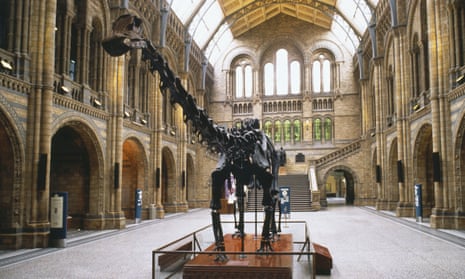In a timely reminder that respiratory infections are not a modern malaise, researchers have found the first evidence of such an affliction in a dinosaur that lived 150m years ago.
Palaeontologists made the discovery when they examined the fossilised neck bones from a diplodocid, a huge, long-necked herbivore that walked the Earth in the late Jurassic period.
Dr Cary Woodruff, director of palaeontology at the Great Plains Dinosaur Museum in Malta, Montana, was inspecting the remains of a dinosaur named Dolly, unearthed in the state more than 30 years ago, when he noticed unusual broccoli-like growths in several of the neck bones.
“I’ve looked at a lot of sauropod vertebrae and I’ve seen some weird things, but never anything like these structures,” Woodruff told the Guardian. Stumped by what he found, Woodruff put a call out on social media for anyone who might know what they were.
The response was almost immediate. A number of scientists – who went on to join the investigation – said the bony growths looked similar to protrusions that can be caused by respiratory infections in modern birds. Detailed CT scans of the neck bones backed up the suspicion.
The unusual growths were in regions of the neck bones that would have been attached to air sacs which in turn formed part of the dinosaur’s respiratory system. The abnormalities may have formed in response to an infection similar to aspergillosis, which is caused by inhaling mould spores, the researchers write in Scientific Reports.
“I imagine that Dolly would have been very much like a sick person: coughing, sneezing, experiencing a fever and out of it,” Woodruff said. “We’ve all had many of the same symptoms, and likely felt just as crummy as Dolly did. I don’t personally know of any fossil I’ve been able to sympathetically relate to more.”
Aspergillosis is fatal to modern birds without treatment. “Did Dolly sadly pass away sick and alone? Or did being on its own and visibly so weak paint a ‘bullseye’ for predators? Either way, we can’t say, but I do believe that in one way or another, it ultimately contributed to the death of Dolly,” Woodruff said. The findings will help researchers understand how such illnesses affected dinosaurs.
“Dinosaurs, including the giant sauropods, breathed through a bird-like air sac system, where the air passed through the lungs as well as systems of air sacs that penetrated into the backbone. The new discovery shows damage to one of the vertebrae that matches the damage seen in birds today that have suffered from inflammation of the air sacs,” said Michael Benton, professor of vertebrate palaeontology at the University of Bristol. “Chickens with airsacculitis can show swollen necks, general lethargy, nasal discharges and coughing. Imagine a 50-tonne dinosaur coughing up great blobs of snot,” he added.
“We know so little about the diseases dinosaurs suffered, unless those maladies were somehow able to leave marks on fossil bone,” said Steve Brusatte, professor of palaeontology and evolution at the University of Edinburgh. “Here we have evidence that a big long-necked dinosaur had the same type of respiratory infection that many birds have today, and we can infer that because the air sacs birds used to breathe actually leave impressions on the bone. It’s remarkable to envision a dinosaur the size of a jetplane coughing and suffering with the same breathing infection as a pigeon or gull today.”
